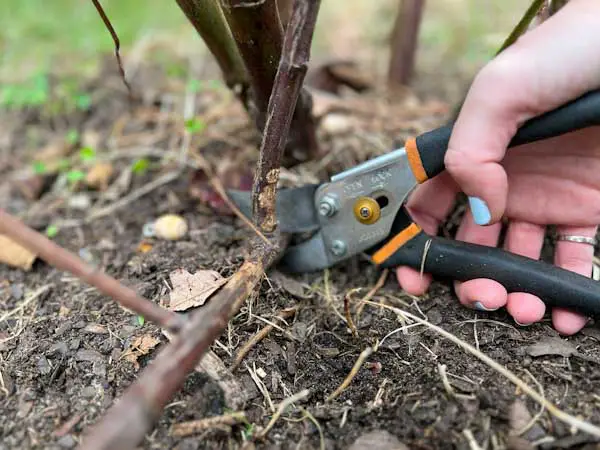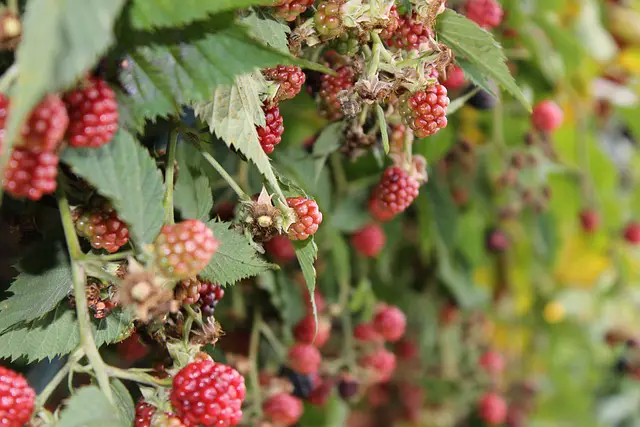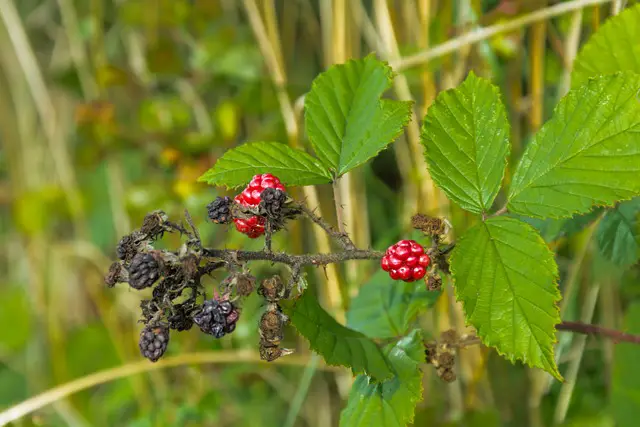
We may receive commissions from purchases made through links in this post, at no additional cost to you.
If you let your blackberry plants grow unchecked, they will soon become a massive thicket of tangled branches. Or, they’ll be a trailing mass of vines that takes over everything in its path. Worst of all, you’re likely to get only a few, small, low-quality berries from such a vigorous plant.
The solution? Pruning. Blackberry bushes need to be pruned – not only to keep the overall size in check, but to increase the size and quality of the berry harvest. But deciding when exactly to prune can be a challenge. So when is the best time to prune blackberry bushes?
Blackberry plants should be pruned in winter or early spring (when dormant) and in summer after fruiting. Everbearing or fall-bearing varieties should also be tip-pruned after the fall harvest. Pruning at these times will improve the plant’s health, control its size, and increase fruit yields.
In this article, we’re removing the confusion about the right time to prune blackberry bushes. Read on to find out not only when to prune, but how to do it.
How do blackberry plants grow?
Before talking about when to prune blackberries, we first have to understand a little about how they grow. Blackberry bushes are perennial plants that produce biennial canes. This means that they fruit on 2-year-old growth.
Each spring, the plant will push up new green canes (the long stems of a blackberry vine) that will continue to grow and leaf out throughout the season. These are called primocanes (primo=first). You’ll recognize them by their bright green color, vigorous growth, dense leaves, and lack of blossoms.
The following season, those primocanes will be in their second year and will become floricanes (flora=flowers). The floricanes will blossom in spring, produce fruit in summer, and then die once the fruit is harvested. They are woodier than the primocanes and are a darker, reddish-green color.

A mature blackberry plant will have both primocanes and floricanes each year. Every season the plant will produce fruit while also preparing for the next year’s fruit.
Since the two different kinds of growth behave differently, they need to be pruned at different times. Knowing how and when to prune each type of cane will increase the size and quality of your blackberry harvest and make the plant stronger and more resistant to disease. Continue reading to find out what to prune and when.
Related: Blackberry Fertilizing: What to Use to Grow the Best Berries
When to Prune Blackberries
Winter/Spring Pruning
Blackberry vines should be tip-pruned in late winter or early spring to strengthen the canes, encourage branching, and control plant size. After removing any dead growth, select the strongest remaining canes and prune them to the desired height, typically 2 to 4 feet.
In the video below, I walk through the steps of pruning my blackberry bushes in the dormant season:
The first step is to remove any dead canes that you didn’t prune in the summer or fall (more on that below). Once that’s done, choose 4 to 6 of the remaining canes to keep, then cut down the rest at ground level. Make sure you keep the strongest, thickest canes and trim any weak-looking ones.

Once the canes start to grow in spring, cut the tip of each cane off at a height of 2 to 4 feet, or at the height of your trellis, if you are using one. This will cause each cane to send out branches below the cut, which will produce fruit later that season. Reducing the length of the cane will also make it stronger and more rigid.
If the cane has any side shoots, prune those to be 12 to 18 inches long. The berries that grow on these shortened branches will be larger, both in size and quantity. (Check out 6 Ways to Grow Bigger, Juicier Blackberries for more ideas.)
Related: Why are My Blackberries Sour? Tips to Grow Sweeter Berries
Summer Pruning
Prune blackberry plants in the summer after fruiting to clean up old growth (the floricanes that grew fruit this year) and encourage new canes to grow. Long primocanes (the canes that did not produce fruit this year) can be tip-pruned now to encourage branching.
Once you’ve harvested all of the blackberries from the floricanes, go ahead and trim them to the ground. Canes that have produced fruit will stop growing and die. Cutting them back now will help the bush conserve energy that it can put toward new growth for next season. It will also increase airflow and reduce the risk of diseases developing.
The vigorous primocanes may need to be pruned to a reasonable height during the summer. I’ve seen these shoots grow to about 12 feet on my own blackberry plants. Trim these canes down to about 4 feet to encourage branching, which will mean more fruit next year.

What if you forgot to prune in the winter? Is it too late to do it now? No, it’s not too late. Pruning in summer may be too late to help this year’s blackberry harvest, but it will set up the plant to produce better next year. Better to do some pruning now than not at all.
Fall Pruning
Late winter and summer are the two main times that blackberry plants need pruning. But there are some circumstances when it is appropriate to prune in the fall, too. Some newer blackberry cultivars are considered fall-bearing, meaning they produce a second, smaller bumper crop of fruit in the fall on that year’s primocanes.
Prune fall-bearing blackberry vines (also called everbearing or primocane blackberries) to remove spent growth after the fall harvest. After fruiting, prune the dead tips of the primocanes that produced berries. Make the cut a couple of nodes below the dead portion of the cane.
Some popular primocane blackberry varieties are ‘Prime-Ark 45’, ‘Prime-Ark Freedom’, and ‘Prime-Ark Horizon.” Many primocane blackberries (including ‘Prime-Jim’ and ‘Prime-Jan’) perform poorly in areas with hot, humid summers since the plants try to set fruits during the hottest part of the season.
Learn more about different blackberry cultivars here: Blackberry Variety Breakdown: Biggest, Sweetest, and More.
Anytime Pruning
Most blackberry pruning is done at the end of winter or early spring when the plant is dormant. But the plants should be pruned at any time to remove dead canes or damaged/diseased branches and fruit.

Removing diseased growth will increase air circulation and reduce the spread of pathogens. Branches that are damaged or broken should be trimmed right away. A clean cut is less likely to invite diseases and pests to the plant.
One last thing – be sure to keep your pruners sharp, clean, and disinfected before making any cuts. I like to use these sturdy Felco-2 hand pruners. I sanitize them by giving them a good, thorough wipe with isopropyl alcohol (plain rubbing alcohol). And you will definitely want to wear some heavy-duty leather (or other strong material) gardening gloves if your blackberry vines have thorns.
Get all the details for how to prune blackberries here: The Ultimate Guide to Pruning Blackberries (with Photos)

